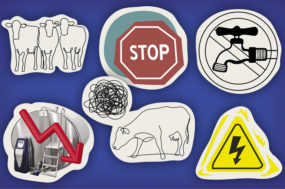While at work, team members often complete tasks that may require them to handle or work around potentially hazardous products. Exposure to these hazardous products can cause injuries or diseases.
Hazards vary significantly depending on the hazardous product being handled and the work conditions. Some hazards that may be present when working with hazardous products include:
- Fire and explosion
- Exposure to gas, fumes or vapours
- Chemical burns
- Chronic and acute illness
The Workplace Hazardous Materials Information System (WHMIS) is Canada’s national hazard communication standard. It is in place to help provide workers with the safety information needed while working with or around hazardous materials. The key elements of the system are hazard classification, cautionary labeling of containers, the provision of safety data sheets (SDS) and worker education and training programs.
Personal protective equipment (PPE)
The type of PPE required will vary significantly depending on the hazardous product being handled and the work conditions. Review the SDS for each hazardous product you may come in contact with to identify the required PPE. Some examples of PPE that may be required when working with hazardous products include:
- Gloves (may be chemical-resistant or other task-specific gloves)
- Eye and face protection
- Respirators
- Protective clothing and chemical-resistant aprons
WHMIS program
A WHMIS program contains three main components all team members who work near or around hazardous materials should be aware of. The three components include:
1. Labels
Two types of labels are included in the WHMIS 2015 requirements. Supplier-provided labels will appear on all hazardous products received at a workplace. Labels that contain all WHMIS 2015 required information must be affixed to the original containers of hazardous products. Workplace labels are provided by employers for any hazardous material when a hazardous product is made at the workplace and used in that workplace, or a hazardous product is poured into another container.
Do not accept or handle any hazardous material that does not have the appropriate labels. Labels that are worn or damaged must be replaced with an equivalent label with all required information.
2. SDS
An SDS provides details on what the hazards of the product are, how to use the product safely, what to expect if the recommendations are not followed, how to recognize symptoms of exposure and what to do if emergencies occur.
SDS provide more detailed information than labels do. They are prepared by the manufacturer or importer of a product. Every product classified under WHMIS in Canada must have an SDS. SDS must be obtained for all hazardous products before they are handled or used in the workplace. An up-to-date SDS must be kept on hand for every hazardous product that is handled, used and stored at the worksite. SDS must be readily available to employees in any location they may handle or store hazardous products.
3. Education
Training is required annually to ensure employees understand the hazards associated with the materials being used and the importance of the information contained on labels and safety data sheets.
Training should include the content required on a supplier label and workplace label; the content required on an SDS; procedures for the safe use, storage, handling and disposal of the hazardous product; and procedures to be followed in case of an emergency involving the hazardous product.
Chemical handling and storage
-
Chemical storage area – Assess the work area and chemicals being stored to determine the best storage location. Where possible, store chemicals in a chemical storage cabinet or other secure location that is dry and climate-controlled. Do not store chemicals in the aisle or other major path of travel. Work areas where hazardous chemicals are stored should be inspected regularly, kept clean, and all spills should be cleaned up right away.
-
Chemical inventory – When ordering new chemicals, review the SDS to ensure you have the capability of storing the materials safely. Keep chemical stocks to a minimum; do not keep an excessive quantity of any hazardous chemicals. Ensure chemicals are stored in appropriate containers that are free of damage or leaks and have tightly closed lids.
-
Chemical compatibility – Store chemicals in groups based on compatibility. Check the SDS for additional information regarding chemical incompatibility. Store flammables in a cool, dry, well-ventilated area, away from direct sunlight, and eliminate ignition sources and combustible materials and do not smoke in areas where flammables are stored.
- Disposal and spills – Dispose of empty, degraded, cracked, corroded or leaking containers as per the instructions found on the WHMIS label or SDS. If a spill occurs, and it is safe to do so, apply the spill kit substance to the spill. Once spill has been absorbed, wear appropriate PPE, sweep absorbent material into a bag, then put that bag into a box and arrange for proper disposal.
Compressed gas handling and storage
- Inspection – Inspect cylinders and equipment prior to use. Inspect each cylinder for leaks, corrosion, pitting, cuts, gouges, bulges, neck defects and general distortion. Inspect cylinder mounting and restraining devices as well as connections and hoses for any leaks, damage or cracks. Inspect regulators and valves for damage, cracks, corrosion or other defects. Ensure you are using the appropriate regulator.
- Handling compressed gas – Compressed gas cylinders must be transported using hand-trucks or other appropriate means. Do not drag or roll cylinders. Cylinders should be transported upright whenever possible. (Always transport acetylene in an upright position.) Ensure the area is adequately ventilated and use the proper PPE when using compressed gas.
- Storage area – Store cylinders in a dry, well-ventilated area away from doorways and aisles. All cylinders must be stored upright and be secured from tipping at all times. Cylinders must be secured using chain or a strap to a solid fixed surface such as a wall or racking upright. Do not store compressed gas cylinders in an area with forklift or other vehicle traffic. Ensure to separate flammable and oxidizing gases. Oxygen and acetylene must be stored at least 20 feet apart when not in use on a welding cart. Store compressed gas cylinders away from heat sources, ignition sources, open flames and flammable (including solvents) and combustible material.
- Propane storage – Propane tanks (including empty tanks and BBQ) must be stored outside, in a locked cage, that is not in the path of vehicle and equipment traffic. Propane cages must be at least 10 feet from any access points to the building and must have a “No Smoking” sign on the cage.
Emergency procedures
If an emergency occurs and a hazardous product is involved, or products are in an area that may contribute to the extent of the emergency, the location’s Emergency Response Plan must be followed, as well as any emergency procedures and guidelines identified on the products’ SDS.









